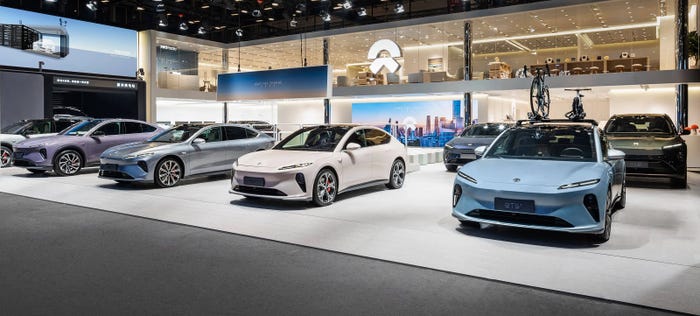Technology Roundup
Bose offers noise-reduction technology without Bose hardware; Distracted-driving-prevention technology migrates from Caterpillar equipment to buses; Silicon-based material designed to extend Li-ion battery life, cut production time.
December 20, 2013

Connectivity Research Builds on Renault’s R-Link System
Renault and Orange Business Services collaborate on research to test the automotive uses of very-high-speed 4G/LTE connectivity.
The project will test new uses made possible by very-high-speed mobile technology in real-life situations, ranging from virtual office and cloud gaming to videoconferencing. An initial test is under way on the Next Two prototypes based on the Renault Zoe all-electric vehicle.
Orange already supplies the SIM M2M cards used in cars equipped with Renault’s R-Link infotainment and navigation system. R-Link, an integrated and connected multimedia touch tablet available on most Renault models, features nearly 100 apps.
“This partnership is an example of an effective working relationship between two very different worlds,” says Remi Bastien, head of engineering innovation at Renault. “We were able to benefit ahead of time from a high-speed LTE network and from Orange’s expertise, with an opportunity to take advantage of the network for our prototype of the connected vehicle of the future.”
Bose Offers Cabin Noise-Management Software
Bose will offer automakers noise-management software integrated on a chip from NXP Semiconductors.
The engineering collaboration with NXP allows vehicles without Bose speakers and amplifiers to use Bose Active Sound Management technology to cancel unwanted engine and powertrain noise in the vehicle’s cabin while eliminating the weight and cost of traditional noise management.
The software will operate in any vehicle using a head unit equipped with NXP’s SAF775x car-radio integrated circuit, and any sound system that performs in the frequency range necessary for active noise cancellation.
Unlike conventional noise-management systems that rely on mechanical solutions, Bose Active Sound Management uses proprietary signal-processing algorithms to replace heavy, space-consuming parts, such as acoustic insulation, mass dampers and active exhaust valves.
The Bose noise-cancellation software is customizable and can be tuned to the manufacturer’s requirements by Bose engineers, providing comprehensive, scalable support for the technology during vehicle development, pre-production and post-production.
Visteon Researches V2X Technology With Eye Toward Autonomous Driving
Visteon Electronics is bolstering its cockpit-electronics capability in support of emerging vehicle-to-vehicle and vehicle-to-infrastructure technology collectively known as V2X.
The electronics supplier will unveil application-ready technology to address V2X communication needs in the U.S. and Europe at next month’s Consumer Electronics Show in Las Vegas. Applications include driver-information-display integration, human-machine interaction design and V2X technology.
V2X technology offers potentially significant improvements in driver awareness, including collision, hazardous road and curve speed warnings and traffic-flow information, and is considered a precursor to autonomous driving.
Visteon is positioning itself to support V2X through both homegrown research and strategic partnerships. The supplier has relationships with industry experts including NXP Semiconductors and Cohda Wireless, which provided the RoadLINK chipset with proprietary embedded-signal-processing firmware to optimize V2X performance in a mobile environment.
Eye-Tracking System Keeps Coach Drivers on Point
Seeing Machines signs an agreement with Royal Beuk, a leading European coach and tour operator, to supply automated fatigue monitoring systems to ensure driver alertness and protect coach passengers.
The system, already available in Caterpillar heavy equipment, is based on patented eye-tracking technology that can detect if a driver is distracted or falling asleep at the wheel.
Using sensing equipment that requires no recalibration between different drivers, the system tracks head alignment for potential distraction of the driver while simultaneously monitoring and analyzing eye behavior to detect microsleeps, some lasting up to 30 seconds.
This enables warnings to be given through in-cab alerts, or for alerts to be provided to operations management for direct intervention.
An initial 20 vehicles selected by Royal Beuk will be equipped with the fatigue-monitoring technology, with plans to expand use of the system across its entire fleet of 60 coaches upon the successful completion of a 9-month evaluation.
Results of the evaluation will be used for the further development and enhancement of the system for use by cars as well as coaches and trucks. Royal Beuk then will act as lead European distributor of the systems for coach and truck fleets across Europe.
Language Service Works With Automakers to Improve Voice-Recognition Interfaces
PALS International, a provider of language and cross-cultural services and training, launches a new service improving natural language processing in automotive infotainment systems for international markets.
The program focuses on testing automotive application and software user interfaces to ensure they are appropriate for local markets around the world. PALS recruits people who are tech-savvy and were born, raised and educated in the local region for which they are offering services, so they understand language and usability nuances that are culturally appropriate.
People who have poor experiences with voice-recognition interfaces are unlikely to continue to use them, PALS says in a news release. PALS helps automakers enhance their global brands by partnering with them to ensure that interfaces, manuals, help files and menus work effectively for target markets.
By bringing global talent to its suburban Detroit offices, PALS fosters person-to-person relationships between its talent and the engineers and auto industry representatives they serve. Growing demand for language diversity has required PALS to recruit talent from around the world. Current automotive clients are requesting services to optimize their systems for more than 30 countries.
Researchers Tout Inexpensive Process for Making 3D-Printed Titanium Auto Parts
U.K. researchers announce a process for manufacturing 3D-printed titanium auto parts.
The technique created by Metalysis creates titanium powder from sand, a process far less costly than the conventional method of atomizing blocks of metal, says Iain Todd, director of the university’s Mercury Centre in the department of materials.
This means auto parts can be made more economically using additive manufacturing rather than traditional subtractive techniques that waste large amounts of the expensive metal and use costly die-set tools, Todd tells The Engineer.
Titanium usually is considered too expensive for use in automotive manufacturing, but the new process could make 3-D printing inexpensive enough for low- to medium-volume production.
Todd’s team has used the material to print parts including impellers and turbochargers. The researchers plan to work with Metalysis to create other materials from titanium powder, particularly alloys that normally would separate when formed from conventional titanium.
Japanese Company Says New Material Triples Li-ion Battery Capacity
Sekisui Chemical develops a material it claims can triple the capacity of lithium-ion batteries, allowing electric vehicles to travel about 360 miles (600 km) on a single charge, several times the range of current EVs.
The new material stores electricity using a silicon alloy instead of conventional carbon-based materials. Seiksui says the alloy resolves the durability issue that has precluded silicon’s use in Li-ion batteries.
Sekisui also announces a new material for the electrolyte, which conducts electricity within the batteries. This eliminates the need for equipment to inject liquid electrolyte into the batteries, increasing battery production tenfold from the current output of about three per hour.
The company believes its new materials can lower battery-production costs to slightly more than ¥30,000 ($290) per kilowatt-hour, compared with about ¥100,000 ($960) today. An official at a major Japanese automaker says EVs could be priced at the same level as gasoline-powered cars if battery prices fell to ¥30,000 per kilowatt-hour, the Nikkei news service reports.
Sekisui plans to begin sample shipments to domestic and overseas battery manufacturers as early as next summer, with mass production to launch in 2015.
You May Also Like



